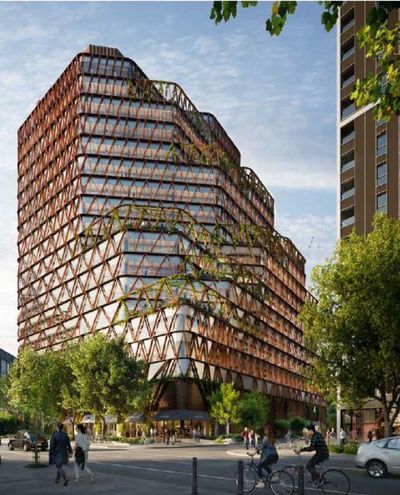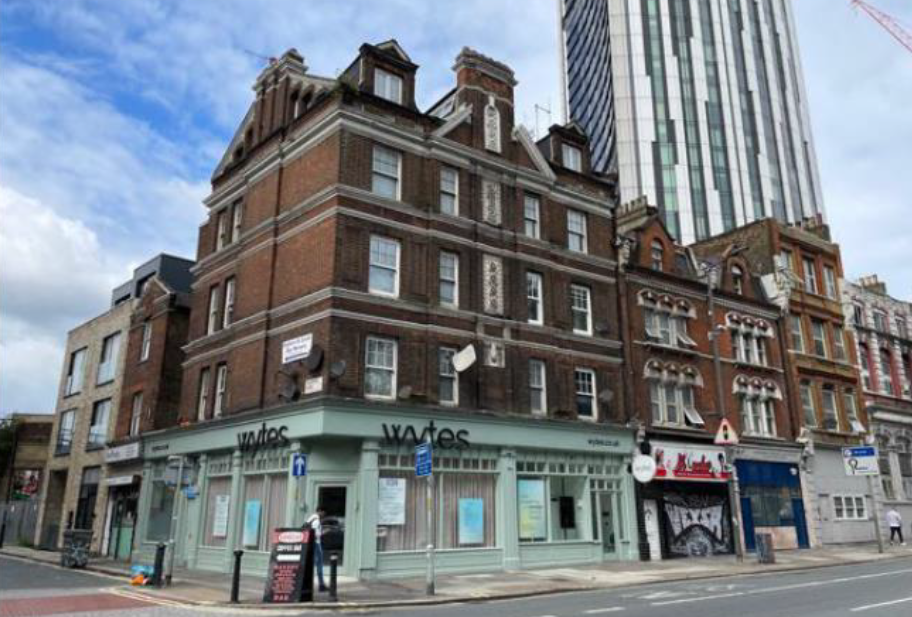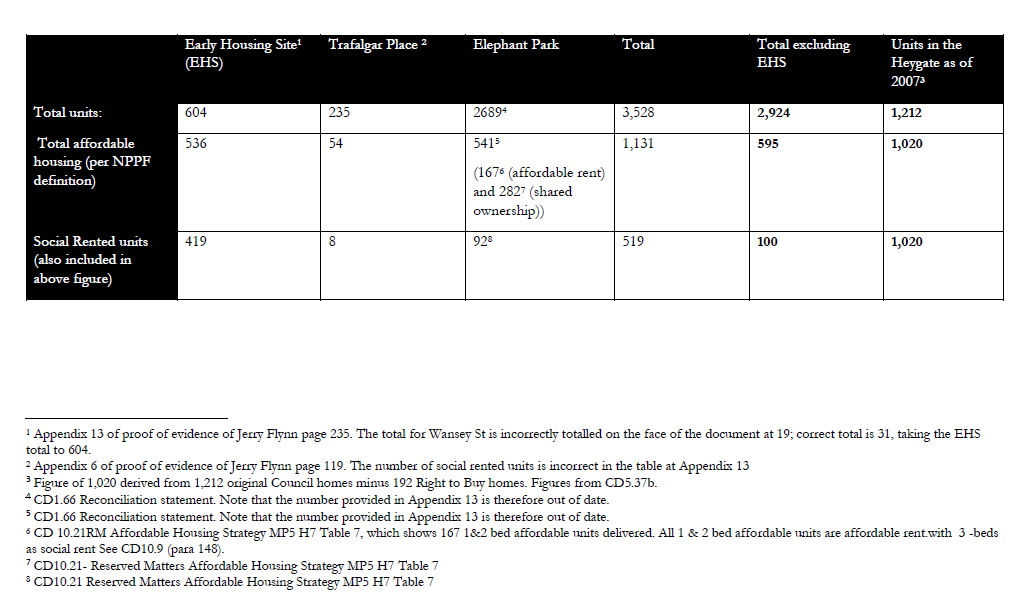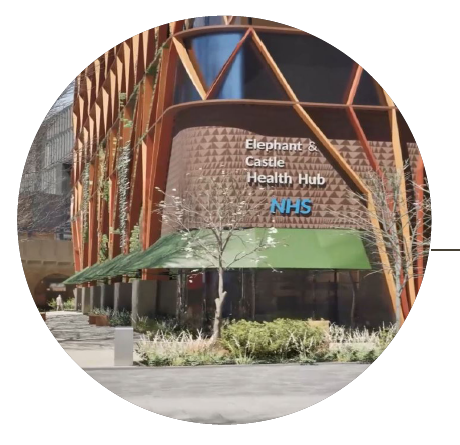
Southwark Council’s decision to refuse Lendlease planning permission for a large office block on H1, the final plot of Elephant Park (formerly the Heygate estate) has been overturned by a planning inspector. The decision means that Lendlease can go ahead with construction of the office block.
The decision comes after an eight-day public inquiry in September, before Inspector Paul Griffiths, appointed by Michael Gove, the Secretary of State for Levelling Up, Housing and Communities. Southwark and the Community Objectors H1 (COH1) argued to maintain the planning committee’s decision, who refused the scheme in October 2022, because of its size, the detrimental impact it would have on the light and privacy of neighbours and harm it would cause to the character of the area. COH1 argued in addition that the H1 site should be used for housing, not offices, as the original outline planning permission, held by Lendlease, required. Southwark Council had no objection to an office block in principle.
The 35% Campaign was part of COH1, which included local residents, housing campaigners and the Walworth Society. COH1 were represented by the Public Interest Law Centre (PILC), the Southwark Law Centre’s Planning Voice Project and barrister Charles Bishop of Landmark Chambers.
What the Inspector thought….
Contrary to Southwark and COH1 the Inspector found the proposed design of the office block to be of a very high standard. He considered that the office block’s shape would be a ‘pleasing’ contrast to the rectilinear forms of the rest of Elephant Park and that it would provide a focus for the development and for the wider Elephant & Castle regeneration. He thought that the design features, such as the lattice work 'cage', the terracing and the ‘ripples’ in the façade, would counteract any impression of oversized bulkiness. He further thought that the high ground floor lobby, with restaurant/cafes, would amount to an extension of the outside public space, with the proposed NHS health hub giving the building a sense of destination.

The Inspector acknowledges that there would be harm to the light of neighbours on Walworth Terrace, just over the road from H1, and in Hurlock Heights on Elephant Park, noting that there would be ‘significant reductions in daylight’ for Nos.82-96 Walworth Road and for ‘all the single aspect north facing master bedrooms in the lower part of Hurlock Heights’. Against this, though, there was a ‘policy expectation’ of a big building on H1, which meant the loss of light was ‘not surprising or extreme’ and therefore acceptable. He also did not think changing the use of the site from a residential to office development made much difference in terms of privacy.
The objectors’ case for homes
COH1 made the case for homes to be built on H1, as originally intended in the Elephant Park masterplan. A full account of all the new homes on the redeveloped Heygate site showed that only 100 were social rent (92 on Elephant Park and eight on Trafalgar Place). This is a fraction of the 1,000-plus council homes that were demolished. Further, only 48 ex-Heygate households had benefited from new homes provided by the regeneration. COH1 therefore argued that the Mayor’s London Plan policy for estate regeneration should apply to Plot H1. This policy (H8) requires that demolished affordable housing be 'replaced by an equivalent amount of affordable housing floorspace' and that 'social rent housing must be provided as social rent housing where it is facilitating a right of return'. (More about the COH1 case can be found on the PILC blog page 28 Sept 2023)
The Inspector acknowledges that COH1's case was ‘perfectly legitimate’ (contrary to Lendlease, who said it was 'inadmissible'), but decided that the question had been settled in 2013, when Southwark determined that off-site replacement housing (the so called Early Housing Sites) was sufficient for rehousing ex-Heygate households. While declining to say whether this was the right or wrong decision, the Inspector could see no compelling reason to re-open the debate. He also saw no reason not to accept an office-use development on H1. (The Inspector praised the design of the Heygate, in passing, in a footnote).

In the Zone – offices before homes….
The Inspector’s decision draws heavily on the policy basis for deciding planning applications. These policies show that building new homes is not necessarily a top priority for either the London Mayor or Southwark Council, regardless of their pronouncements otherwise.
The Mayor tells us in his London Plan 2021 that office-building is as important as home-building at the Elephant and Castle, because it is in the Central Activities Zone (CAZ). The Plan says that in the CAZ ‘The nationally and internationally significant office functions of the CAZ should be supported and enhanced….and ‘New residential development should not compromise the strategic functions of the CAZ’ (Policy SD4).
For its part, Southwark Council gave Lendlease an indispensable helping hand, by introducing the Southwark Plan Policy ST2, in 2022. This increases the amount of office space on Elephant Park from the 5,000sqm that Lendlease were allowed under their original 2013 planning permission, to 60,000sqm (a decision Lendlease uncannily anticipated in 2017, by hiring Acme architects to design an office block for H1 of almost exactly that size).
The Inspector notes all this, as well several other policies, including London Plan policy SD5, by which housing cannot be given more weight than offices in planning decisions for CAZ developments. In an important passage he says ‘the provision of offices on the appeal site draws support from both the London Plan and the Southwark Plan. Indeed, London Plan Policy SD5 expresses no preference for residential development over offices and/or other strategic functions in the Central Activities Zone, or vice versa. There is no policy basis, therefore, for a conclusion that housing and affordable housing would be a better use for the site.’
A smaller health hub?

A particularly disappointing aspect of the decision is that the Inspector favoured Lendlease’s version of the s106 legal agreement for the Health Hub, over both the COH1 and Southwark Council versions. Lendlease’s version leaves the exact size and length of lease open to negotiation with the NHS. The Inspector’s reasoning is that this would make it more likely that the health hub would become a reality. This may be true, but it also opens the door to Lendlease providing something smaller and on a shorter lease, than the 10% of total workspace and 30-year lease that they had committed at the planning committee meeting in October 2022.
What we say….
Lendlease could not have succeeded in this appeal without the 2021/2022 changes to planning policy, which increased the office space they were allowed to build twelvefold, to 60,000sqm. This change was made by Southwark Council, facilitated by the Mayor's London Plan. It was a change which Lendlease was well prepared for, having, with remarkable foresight, already hired Acme architects four years previously, to build an office block almost exactly that size (a point acknowledged by both ACME and Lendlease advisor, DP9, at the inquiry).
We blogged in September 2021, about these late policy changes to the Southwark Plan. We also noted other major changes to the Heygate redevelopment, departing from the scheme which had been presented and approved by Southwark's planning committee in January 2013 – more homes on fewer plots, 900 free-market homes to be let, not sold – plus the substantial number of homes sold overseas.
Now Lendlease has also strengthened its position in negotiations with the NHS for the provision of a health hub, which by all accounts looks as if it will be incorporating two GPS's surgeries, Princess St and Manor Place. Southwark Council will also be party to these negotiations, but as the Southwark Law Centre has pointed out in our previous blogpost 'Any figures put forward by Lendlease would involve subjective estimates that would no doubt skew things in their favour. The Council would have the ability to review these figures, but they would likely lack the resources and the data needed to properly scrutinise them’.